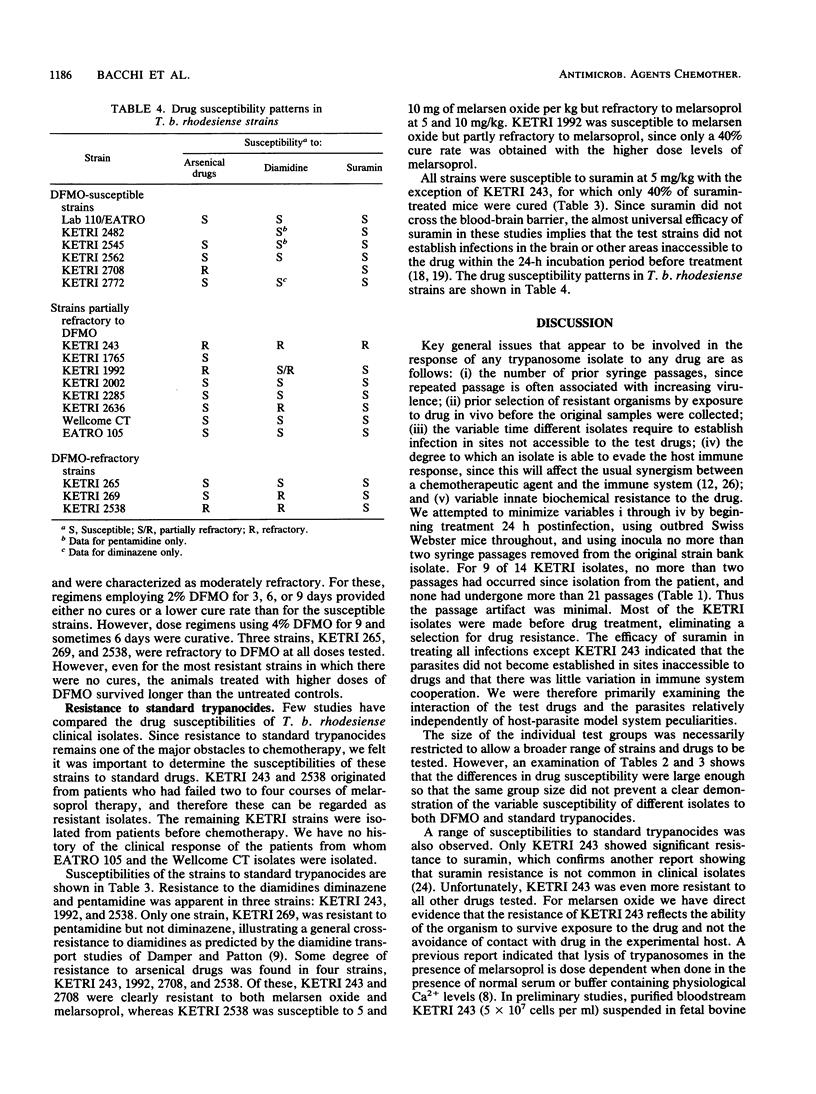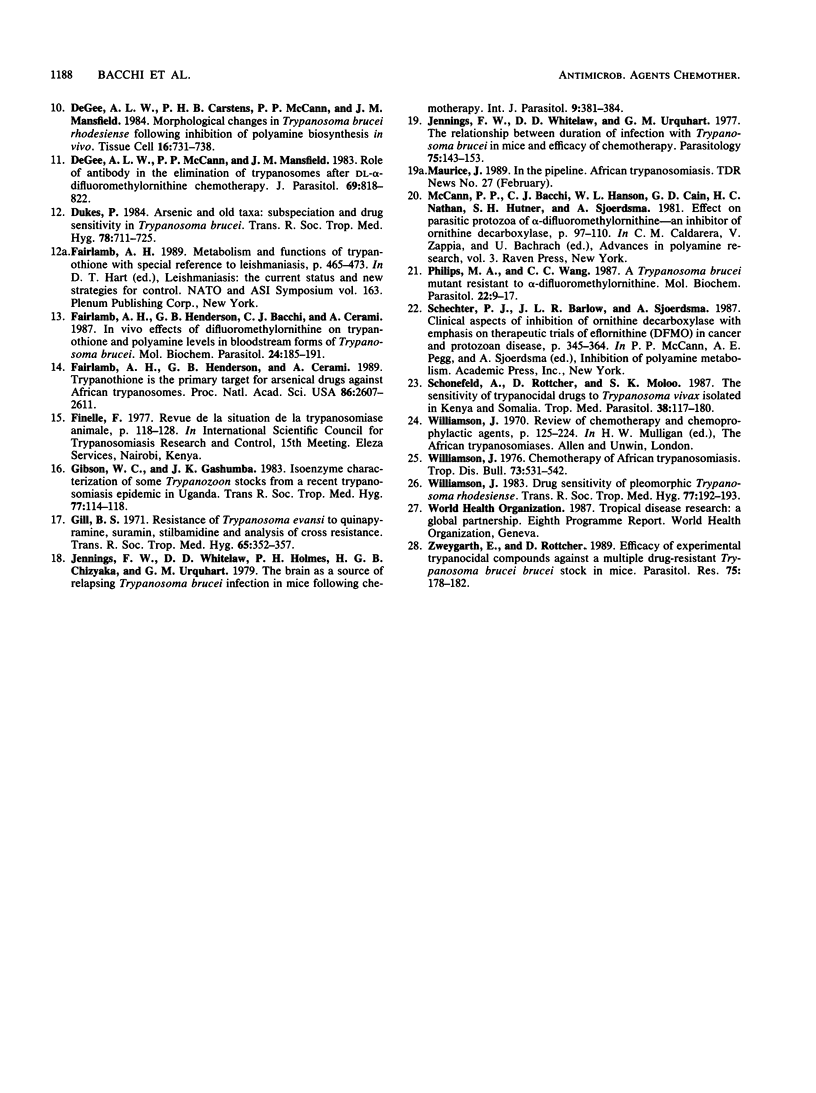Abstract
DL-alpha-Difluoromethylornithine is an enzyme-activated inhibitor of ornithine decarboxylase and an antagonist of polyamine metabolism that has been successful in clinical trials against West African sleeping sickness caused by Trypanosoma brucei gambiense. Its potential for use against the more virulent East African form of the disease, caused by T. brucei rhodesiense, is not certain. We examined 14 East African clinical isolates from the Kenya Trypanosomiasis Research Institute strain bank plus 2 established isolates for susceptibility to DL-alpha-difluoromethylornithine and to standard trypanocides. Seven of 16 strains were partially or totally refractory to DL-alpha-difluoromethylornithine in our test system. Four strains were also refractory to arsenical drugs, and five were refractory to diamidines. The results indicate that other novel agents or combinations of established agents may be needed for chemotherapy of East African disease.
Full text
PDF





Selected References
These references are in PubMed. This may not be the complete list of references from this article.
- Bacchi C. J., Garofalo J., Mockenhaupt D., McCann P. P., Diekema K. A., Pegg A. E., Nathan H. C., Mullaney E. A., Chunosoff L., Sjoerdsma A. In vivo effects of alpha-DL-difluoromethylornithine on the metabolism and morphology of Trypanosoma brucei brucei. Mol Biochem Parasitol. 1983 Mar;7(3):209–225. doi: 10.1016/0166-6851(83)90022-1. [DOI] [PubMed] [Google Scholar]
- Bacchi C. J., Nathan H. C., Clarkson A. B., Jr, Bienen E. J., Bitonti A. J., McCann P. P., Sjoerdsma A. Effects of the ornithine decarboxylase inhibitors DL-alpha-difluoromethylornithine and alpha-monofluoromethyldehydroornithine methyl ester alone and in combination with suramin against Trypanosoma brucei brucei central nervous system models. Am J Trop Med Hyg. 1987 Jan;36(1):46–52. doi: 10.4269/ajtmh.1987.36.46. [DOI] [PubMed] [Google Scholar]
- Bellofatto V., Fairlamb A. H., Henderson G. B., Cross G. A. Biochemical changes associated with alpha-difluoromethylornithine uptake and resistance in Trypanosoma brucei. Mol Biochem Parasitol. 1987 Oct;25(3):227–238. doi: 10.1016/0166-6851(87)90086-7. [DOI] [PubMed] [Google Scholar]
- Bitonti A. J., Cross-Doersen D. E., McCann P. P. Effects of alpha-difluoromethylornithine on protein synthesis and synthesis of the variant-specific glycoprotein (VSG) in Trypanosoma brucei brucei. Biochem J. 1988 Feb 15;250(1):295–298. doi: 10.1042/bj2500295. [DOI] [PMC free article] [PubMed] [Google Scholar]
- Bitonti A. J., McCann P. P., Sjoerdsma A. Necessity of antibody response in the treatment of African trypanosomiasis with alpha-difluoromethylornithine. Biochem Pharmacol. 1986 Jan 15;35(2):331–334. doi: 10.1016/0006-2952(86)90534-4. [DOI] [PubMed] [Google Scholar]
- Brohn F. H., Clarkson A. B., Jr Quantitative effects of salycylhydroxamic acid and glycerol on Trypanosoma brucei glycolysis in vitro and in vivo. Acta Trop. 1978 Mar;35(1):23–33. [PubMed] [Google Scholar]
- Clarkson A. B., Jr, Amole B. O. Role of calcium in trypanocidal drug action. Science. 1982 Jun 18;216(4552):1321–1323. doi: 10.1126/science.6805075. [DOI] [PubMed] [Google Scholar]
- Damper D., Patton C. L. Pentamidine transport and sensitivity in brucei-group trypanosomes. J Protozool. 1976 May;23(2):349–356. doi: 10.1111/j.1550-7408.1976.tb03787.x. [DOI] [PubMed] [Google Scholar]
- Dukes P. Arsenic and old taxa: subspeciation and drug sensitivity in Trypanosoma brucei. Trans R Soc Trop Med Hyg. 1984;78(6):711–725. doi: 10.1016/0035-9203(84)90002-6. [DOI] [PubMed] [Google Scholar]
- Fairlamb A. H., Henderson G. B., Bacchi C. J., Cerami A. In vivo effects of difluoromethylornithine on trypanothione and polyamine levels in bloodstream forms of Trypanosoma brucei. Mol Biochem Parasitol. 1987 Jun;24(2):185–191. doi: 10.1016/0166-6851(87)90105-8. [DOI] [PubMed] [Google Scholar]
- Fairlamb A. H., Henderson G. B., Cerami A. Trypanothione is the primary target for arsenical drugs against African trypanosomes. Proc Natl Acad Sci U S A. 1989 Apr;86(8):2607–2611. doi: 10.1073/pnas.86.8.2607. [DOI] [PMC free article] [PubMed] [Google Scholar]
- Gibson W. C., Gashumba J. K. Isoenzyme characterization of some Trypanozoon stocks from a recent trypanosomiasis epidemic in Uganda. Trans R Soc Trop Med Hyg. 1983;77(1):114–118. doi: 10.1016/0035-9203(83)90033-0. [DOI] [PubMed] [Google Scholar]
- Gill B. S. Resistance of Trypanosoma evansi to quinapyramine, suramin, stilbamidine and tryparsamide and analysis of cross-resistance. Trans R Soc Trop Med Hyg. 1971;65(3):352–357. doi: 10.1016/0035-9203(71)90013-7. [DOI] [PubMed] [Google Scholar]
- Jennings F. W., Whitelaw D. D., Holmes P. H., Chizyuka H. G., Urquhart G. M. The brain as a source of relapsing Trypanosoma brucei infection in mice after chemotherapy. Int J Parasitol. 1979 Aug;9(4):381–384. doi: 10.1016/0020-7519(79)90089-4. [DOI] [PubMed] [Google Scholar]
- Jennings F. W., Whitelaw D. D., Urquhart G. M. The relationship between duration of infection with Trypanosoma brucei in mice and the efficacy of chemotherapy. Parasitology. 1977 Oct;75(2):143–153. doi: 10.1017/s0031182000062284. [DOI] [PubMed] [Google Scholar]
- Phillips M. A., Wang C. C. A Trypanosoma brucei mutant resistant to alpha-difluoromethylornithine. Mol Biochem Parasitol. 1987 Jan 2;22(1):9–17. doi: 10.1016/0166-6851(87)90064-8. [DOI] [PubMed] [Google Scholar]
- Schönefeld A., Röttcher D., Moloo S. K. The sensitivity to trypanocidal drugs of Trypanosoma vivax isolated in Kenya and Somalia. Trop Med Parasitol. 1987 Sep;38(3):177–180. [PubMed] [Google Scholar]
- Williamson J. Chemotherapy of African trypanosomiasis. Trop Dis Bull. 1976 Jul;73(7):531–542. [PubMed] [Google Scholar]
- Williamson J. Drug sensitivity of pleomorphic Trypanosoma rhodesiense. Trans R Soc Trop Med Hyg. 1983;77(2):192–193. doi: 10.1016/0035-9203(83)90066-4. [DOI] [PubMed] [Google Scholar]
- Zweygarth E., Röttcher D. Efficacy of experimental trypanocidal compounds against a multiple drug-resistant Trypanosoma brucei brucei stock in mice. Parasitol Res. 1989;75(3):178–182. doi: 10.1007/BF00931271. [DOI] [PubMed] [Google Scholar]
- de Gee A. L., Carstens P. H., McCann P. P., Mansfield J. M. Morphological changes in Trypanosoma brucei rhodesiense following inhibition of polyamine biosynthesis in vivo. Tissue Cell. 1984;16(5):731–738. doi: 10.1016/0040-8166(84)90006-5. [DOI] [PubMed] [Google Scholar]
- de Gee A. L., McCann P. P., Mansfield J. M. Role of antibody in the elimination of trypanosomes after DL-alpha-difluoromethylornithine chemotherapy. J Parasitol. 1983 Oct;69(5):818–822. [PubMed] [Google Scholar]


